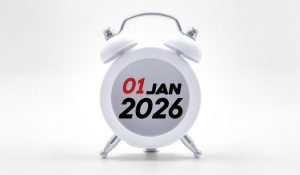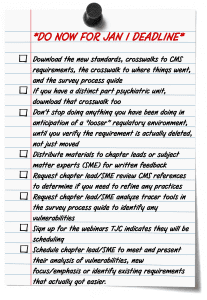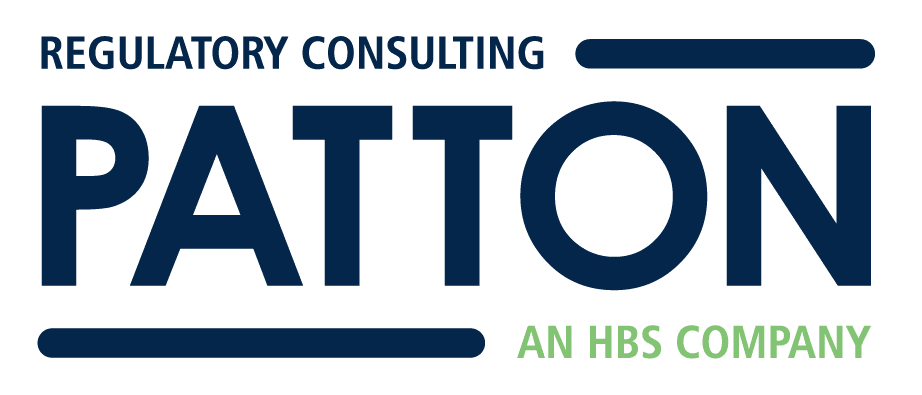July 2025
Inside This Issue
New Deemed HAP and CAH Manuals:

The last couple of months we have commented on how little new information was published in Perspectives. Well, TJC is making up for that brief rest period by announcing new deemed manuals for hospitals and critical access hospitals, consolidation of elements of performance into a 146-page hospital manual, new terminology like “National Performance Goals” instead of NPSG, new crosswalks, and a 629-page Survey Process Guide, formerly called a Survey Activity Guide. All of this becomes effective January 1, 2026, but most importantly TJC states that there are no new concepts included in the new formatting.
While this much new information may seem daunting, TJC has posted many tools to its prepublication standards page to help sort through these changes. Do go there now and download all these materials to start your analysis. One such tool is called a crosswalk compare, which shows you where everything went, from the old standard and EP number to the new standard and EP number, and where this same requirement resides in the CMS state operations manual.

Having access to this tool in 2026 will be helpful, when you are thinking of an old familiar standard and wondering where it went.
We also noted that TJC has stated they will no longer have a customer Survey Activity Guide and a second “internal use only” surveyor guide with content not available to accredited organizations. This is a step in the right direction, and we noted that the new survey process guide contains some useful tools for accredited hospitals such as the kitchen tracer tool, IC program assessment, imaging tool, PI tool checklist, PI tracer tool, antibiotic stewardship tool, workplace violence tool, EM tool, and healthcare equity evaluation tool.
The always challenging EC and LS chapters have been merged into one new Physical Environment chapter, or PE chapter. The survey process guide also now includes a copy of the CMS K tags, used to evaluate the physical environment.
TJC has eliminated its former “risk icon” which TJC indicates has been in use since 2013, for those requirements thought to be of higher importance, but surveyors will continue to assign a criticality factor using the SAFER Matrix on survey reports. There are also many links to specific CMS standards using the 42 CFR.482.xx format, which you can use to read the guidance or additional details CMS may include in the State Operations Manual for Hospitals or Critical Access Hospitals.
TJC has indicated it will be making some webinars available to help explain the new content and format. These should begin to be available in August. For those of you who use chapter leaders you will want to make these new postings available to your leads and ask them to review and analyze the new materials. We would also encourage them to read the CMS reference sections and any of the newly published tracer tools to add depth to their understanding. While TJC has indicated there are no new requirements, a new EP format or tracer tool may now make something clearer than it had been in the past, requiring policy or training refinement. For those of you who have not previously used chapter leaders, you may want to appoint chapter leaders or chapter teams to get the most appropriate subject matter experts analyzing all these changes and looking for potential gaps.
 In summary, there is a lot of “new” or reformatted material here that will require analysis. We would suggest doing the following in preparation for 2026.
In summary, there is a lot of “new” or reformatted material here that will require analysis. We would suggest doing the following in preparation for 2026.
- Download the new standards, crosswalks to CMS requirements, the crosswalk to where things went, and the survey process guide
- If you have a distinct part psychiatric unit, download that crosswalk too
- Don’t stop doing anything you have been doing in anticipation of a “looser” regulatory environment, until you verify the requirement is actually deleted, not just moved
- Distribute materials to chapter leads or subject matter experts (SME) for written feedback
- Request chapter lead/SME review CMS references to determine if you need to refine any practices
- Request chapter lead/SME analyze tracer tools in the survey process guide to identify any vulnerabilities
- Sign up for the webinars TJC indicates they will be scheduling
- Schedule chapter lead/SME to meet and present their analysis of vulnerabilities, new focus/emphasis or identify existing requirements that actually got easier.
 Rural Health Clinic Standards Update:
Rural Health Clinic Standards Update:
TJC announced they have created a new EP 8 and modified EP 9 of LD.04.03.01 in their Rural Health Clinic standards. The new EP 8 requires that the RHC offer primary care services. The revised EP 9 is actually a simplification of the required onsite laboratory testing which must be performed, eliminating the requirement to offer hemoglobin/hematocrit and examination of stool specimens for occult blood. The wording of the bullet point discussing culturing has been modified to require “collection of patient specimens for transmittal to a certified laboratory for culturing.”
 Staff Training and Education:
Staff Training and Education:
This month’s Consistent Interpretation column discusses HR.01.05.03, EP 1, which requires that staff participate in ongoing education and training to maintain or increase their competency which was scored noncompliant in just under 2% of surveys last year. The guidance/interpretation section seems strongly worded to redirect surveyors to alternative scoring locations depending on the nature of their finding, however, there does not appear to be any revelations that organizations might use to strengthen their training programs.
 Workplace Violence Prevention Case Study:
Workplace Violence Prevention Case Study:
EC News has an informative article about work taking place at Dartmouth Health relative to workplace violence prevention. Dartmouth had a shooting take place in their intensive care unit back in 2017 and they have been working as a system since to enhance their WPV prevention program. They designed a 30 minute e-learning module for all staff and developed an in-person training program containing 3 levels of training: basic, self-defense tactics and techniques, and detailed defensive control techniques. The level 3 training is required for security, psychiatric and emergency department staff. They have also enhanced their personal duress system and are using artificial intelligence to identify people entering the premises who may have restraining orders or are known to be violent. You will want to share this article with your own team addressing WPV at your organizations.
 Construction Safety:
Construction Safety:
Last month we described the June EC News article on controlling construction dust and debris. This month they have an even more detailed discussion about PCRA, ICRA, ILSM and safely managing construction projects. The article is 6 total pages in length and includes 5 content headers, each worthy of self-assessment and validation. These content headers include:
- Mitigation strategies for utilities
- Interim Life Safety Code measures
- Cleanliness and ventilation
- Construction waste management
- Construction equipment safety, security and PPE
As your team reviews this content, we would encourage readers to verify their policies adequately discuss these issues, content addresses each of the bullet points in each content section, and that you have evidence that these issues have been addressed in preparation for recent construction activities.
 Hyperbaric Compliance:
Hyperbaric Compliance:
The July issue of EC News has a refresher article on hyperbaric chamber compliance and readiness. The article includes an updated version of the JCR hyperbaric chamber compliance tool discussed in March 2023. Given the potential for turnover in staff, it is likely a good time to re-examine compliance efforts with this common, but high risk service.

Cybersecurity:
TJC published its latest edition of Emergency Management Leader in mid-June. This issue contains several articles from presentations delivered at the JCR Emergency Management Conference held back in April. The first of these is on the issue of cybersecurity, presented by TJC’s Director of Enterprise IT Security. He reminded readers to include cybersecurity breaches in your hazard vulnerability analysis, HVA. Unfortunately, he also advised that a breach is “not a matter of if, it’s a matter of when.”
 Labor Strikes:
Labor Strikes:
A second presentation discussed was about preparation for a labor strike. This was prepared by leaders from Northwell Health, a large New York based system with multiple collective bargaining agreements and unions. The authors advise that if your organization has collective bargaining agreements, then the potential for a strike or other job action should be considered in your HVA. The good news is that preparation for a strike is somewhat more predictable than an approaching hurricane, because you know when your agreements expire and in healthcare unions must provide 10 days advance notice prior to a strike.
The authors suggested that if your plans include temporary staff, you should begin your planning and onboarding activities well ahead of time. They also cautioned that certain vendors may not be willing to cross picket lines to deliver essential goods or services during a strike. If you’re in an organization with collective bargaining agreements, you will want to review your EM planning to ensure that this potentiality is considered. We would suggest sharing this article with your EM team if this is applicable.
 Emergency Management Planning:
Emergency Management Planning:
There was a third presentation and article from Lifepoint Health, a health system with multiple facilities in North Carolina, which was heavily impacted by Hurricane Helene last September. When you are developing your EM exercises you want to throw additional obstacles into the mix to challenge your planning, and the authors of this article identify challenges you might not have previously considered.
For example, all communications were down, including roads, internet, landlines, and cell phones. They thought they were prepared with back up satellite phones, but lack of use and familiarity with their functioning, coupled with service plans lapsing, made them unusable. They also mentioned that their community and vendors went back to a cash economy because banks were closed, the internet was down, and both the facilities and their employees needed cash to continue to function. EM plans often contain contingency actions for generator fuel, but given the impact and duration of Helene, hospital employees needed access to gasoline just to come to work. If you live in hurricane country, you will want to share this article with your EM team.
 Terror Attack Impacts on Healthcare:
Terror Attack Impacts on Healthcare:
Lastly, there is a detailed article on potential terrorist attacks and discussion of the impacts on healthcare. There is a link to the Homeland Security Threat Assessment 2025, which provides insight on issues many readers may not have previously considered in their EM planning. Healthcare facilities may be the target of the attack or may be needed in response to an attack in your community.
The authors provide some suggestions for preparing for what is called a CBRNE attack, which is a chemical, biological, radiological, nuclear or explosive attack. While we might think of the potential for such an attack as remote, the severity of the impact makes on-the-job learning in response inadequate. Thus, this may be an opportune time to strengthen your EM plan for this low probability but very high impact event.
![]()
DNV: Healthcare Symposium; New Hospital and Critical Access Hospital Standards:
DNV will be holding their annual Healthcare Symposium conference in Costa Mesa California October 20-23, 2025. Visit 2025 DNV Healthcare Symposium for registration and information materials.
DNV has also announced changes to their hospital and critical access hospital requirements, some effective 9/8/25 and some related to new CMS requirements for obstetrical services effective in January 2027. You can download their materials using the links below.
- Download the Rev. 25-1 requirements for hospitals
- Download the Rev. 25-1 change history for hospitals
- Download the Rev. 25-1 requirements for critical access hospitals
- Download the Rev. 25-1 change history for critical access hospitals
![]() ACHC: New: Article for Office Based Surgery; The Surveyor Issue:
ACHC: New: Article for Office Based Surgery; The Surveyor Issue:
ACHC has a July post on their website, The ABC+D of Plans of Correction: A Practical Guide for OBS Leaders, on developing plans of correction. The post is targeted to an office based surgery setting, however the well-organized guidance offered is pertinent to any healthcare setting.
ACHC has also posted the first issue in 2025 of their online newsletter called The Surveyor. This issue coins a term called an accreditation nerd for those of us who focus on accreditation, quality improvement and compliance. Their publication also provides a broad overview of their programs and services.
 CIHQ: Accreditation and Regulatory Summit:
CIHQ: Accreditation and Regulatory Summit:
CIHQ is holding their annual Accreditation and Regulatory Summit from October 21-23, 2025, in San Antonio. Visit 2025 Accreditation and Regulatory Summit: Are You Gambling with Your Compliance? to access conference information and registration details.

Public Release of CMS Inspection Reports:
The last few months there has been little new information from CMS, but like TJC they appear to be making up for lost time. The first memo you will want to review is QSO 25-19 dated 6/18/25. This indicates that CMS will be publicly releasing their inspection reports on form 2567 within 14 days of sending it to the provider. Which means that you may be developing your plans of correction at the same time you begin to receive media inquiries about that same report. This likely means you will want to have staff focused in developing the POC, and staff ready to handle media inquiries. CMS indicates that this policy does not generally affect survey reports from accreditors but does affect home health and hospice accreditation reports, which will be shared publicly.

Laboratory Updates:
On 6/23/25, CMS posted QSO 25-10-CLIA along with a revised state operations manual for laboratories, appendix C. The QSO memo clarifies educational requirements for staff performing laboratory testing that had led to some concern from the pre-release version of Appendix C posted in late 2024. CMS has also attached an edited version of the entire Appendix C for laboratories attached to the QSO memo.
Also, on 6/23/25 CMS posted QSO 25-21-CLIA relative to what they call “enforcement discretion” for laboratory directors. It appears that the regulations may be overly restrictive, and it will take time to change those regulations, so CMS is creating some flexibility on how they will enforce qualification requirements for laboratory directors until those regulations can be modified.
On 6/27/25 CMS posted QSO 25-22-CLIA discussing CMS complaint investigation procedures for laboratories. This memo differentiates how they will do complaint investigations in different types of laboratories and details timeframes for CMS to analyze each complaint. This revises chapter 5, complaint procedures for laboratories and revised content are displayed in red as new material.
Readers will want to share these three lab memos with your lab leadership and seek guidance on what if any changes are needed in your organization or if there are implications.
Thank You!
Jennifer Cowel, RN MHSA
JenCowel@PattonHC.com
Kurt Patton, MS RPh
Kurt@PattonHC.com
Julia Finken, RN, BSN, MBA, CPHQ
julia.finken@hbsinc.com
John Rosing, MHA
JohnRosing@PattonHC.com
